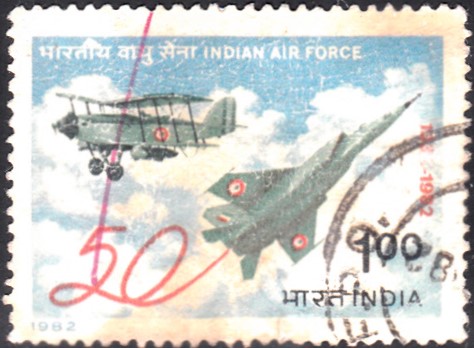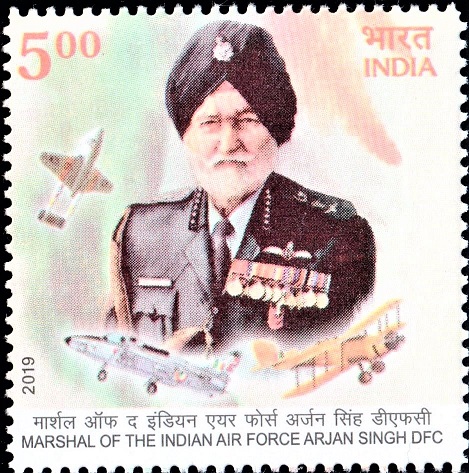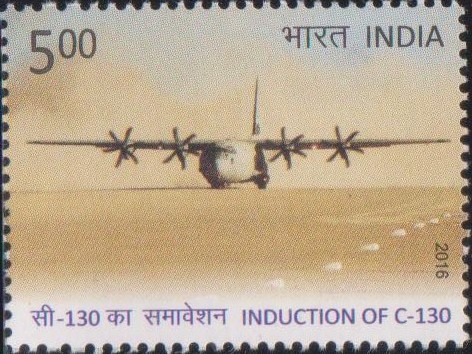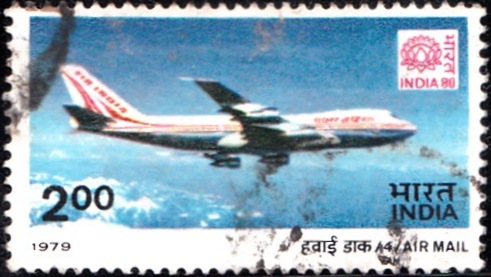
Indian Air Force 1982
A commemorative postage stamp on the 50th Anniversary of the Indian Air Force (IAF) :
 Issued by India
Issued by India
Issued on Oct 8, 1982
Issued for : The Posts and Telegraphs Department is privileged to issue a commemorative stamp on the occasion of the Golden Jubilee Celebrations of the Indian Air Force.
Description of Designs : The stamp depicts the oldest and latest aircraft, the Wapiti and the Mig-25 flown by the Indian Air Force. The first day cover depicts the Insignia adopted for the Golden Jubilee Celebrations and a Jaguar aircraft. The stamp, first day cover and cancellation has been designed by R.N. Pasricha.
Type : Stamp, Postal Used
Colour : Multicolour
Denomination : 100 Paise
Overall size : 3.91 x 2.90 cms.
Printing size : 3.55 x 2.54 cms.
Perforation : 13 x 13
Paper : Unwatermarked adhesive stamp paper
Number printed : 20,00,000
Number per issue sheet : 35
Printing process : Photogravure
Printed at : India Security Press
About :
- In the early dawn of our freedom struggle, our statesmen and leaders, envisioning a strong independent India, prevailed upon the Government to form an Air Force. This vision became a reality on October 8, 1932 with the Indian Air Force Act becoming effective and the commissioning of the first batch of Indian pilots at Cranwell in the United Kingdom.
- On April 1, 1933 a nucleus of the Indian Air Force comprising six officers, twenty two Hawai Sepoys and four Westland Wapiti aircraft, was formed at Drigh Road, Karachi. Four years later this small, yet effective, force operated from Miranshah in North Waziristan to subdue a rebellion which was its first battle experience. By 1939, the IAF expanded to six flights which guarded our coastline.
- The outbreak of World War II brought about a very rapid expansion of the IAF. From only six flights in 1939, its strength rose to seven full squadrons in 1943 and to ten squadrons in 1945, five flying Hurricanes and the others Spitfires. All these squadrons, at one time or the other, saw action in Burma and gained valuable battle experience in a real blood and sweat war.
- Partition in 1947 left India with only five and a half squadrons of fighter aircraft and one transport squadron. In its wake came the greatest exodus in history. The IAF geared itself to the momentous task of evacuating people across the new border. Immediately thereafter, Kashmir was invaded and, against time and enemy fire, the India Army was airlifted to Srinagar in the nick of time to rout the enemy. The rest is history.
- In 1948, the IAF was the first Asian Air Force to move into the jet-age with the acquisition of Vampires. In 1950, the IAF provided rapid aid in dropping relief supplies and evacuating victims of the earthquake which devastated major parts of Assam. In 1962, during the Chinese aggression, the IAF flew myriad sorties to provide logistic support to our Army and civil administration, over and through the formidable mountains in Ladakh and NEFA (now known as Arunachal Pradesh). Again in 1965, when the attack by the Pakistan armoured division formed a seemingly impregnable bridgehead in the Chhamb–Jaurian area, threatening to isolate Kashmir, the IAF, battling both the superior PAF Sabres and enemy tanks, turned the tables to our advantage. Unleashed once again, in 1971, to protect our country’s interests, the IAF played a stellar role in our victory, both in the eastern and western theatres.
- The IAF, sustained by the great patriotism of the people of India, faces the future with confidence. It is becoming increasingly self-reliant with modern, sophisticated aircraft being built in Indian factories. Its personnel are drawn from all parts of the Country, from all religions, castes and creeds. They are unwavering in their resolve to meet all challenges, be it aggression in war or swift aid to our people in distress during natural calamities or accidents. They train hard to touch the Indian skies with glory.
- (Text by courtesy : Air Headquarters).








[…] Indian Air Force’s C-130J Super Hercules is an Advanced Mobility Special Operations Platform with maximum payload […]